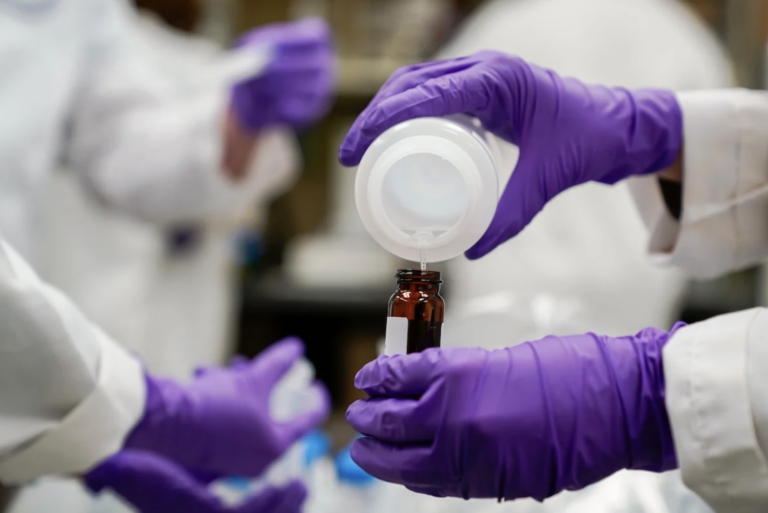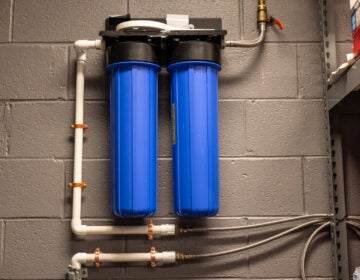Nearly 19% of water systems tested in Pa. contain PFAS levels above new EPA standards
In the Philly region, “forever chemicals” exceeded Pa.’s maximum contaminant levels in Bucks, Chester and Montgomery counties.
Listen 1:42
A water researcher pours a water sample into a smaller glass container for experimentation as part of drinking water and PFAS research at the U.S. Environmental Protection Agency Center for Environmental Solutions and Emergency Response, Thursday, Feb. 16, 2023. (AP Photo/Joshua A. Bickel)
From Philly and the Pa. suburbs to South Jersey and Delaware, what would you like WHYY News to cover? Let us know!
Public water providers across the U.S. are grappling with new federal Environmental Protection Agency regulations that require them to test their drinking water for toxic PFAS, and reduce the so-called “forever chemicals” to almost zero over the next five years.
The goal is to address increasing concerns about PFAS, a large class of chemicals found in hundreds of everyday products, such as nonstick cookware and waterproof clothing, as well as firefighting foam.
The consequences of exposure to PFAS are long-lasting — the compounds can stay in the environment, and the human bloodstream, for years. The chemicals have been linked to some cancers, thyroid disease, ulcerative colitis, developmental delays in children and other health conditions.
Public water providers in Pennsylvania recently completed PFAS testing to meet the state’s own requirements that were implemented last year to tackle the chemicals.
Providers serving more than 350 people were required in January to start testing their drinking water for PFAS. Nearly 19% of the water systems tested statewide between January and March of 2024 submitted water samples that contained PFAS levels above the new federal regulations, according to newly published data of 1,059 water systems analyzed by WHYY News.
More than 2.5% — or 27 of these water systems — submitted water samples that contained PFAS at levels that fail to meet the state’s own regulations, which allow for higher levels of the chemicals in drinking water.
These water systems can be publicly or privately owned, and are operated by investor-owned utilities, municipalities, small communities, schools and businesses. Larger water providers may operate multiple water systems for their customers in various counties.
A majority of the water systems with high levels of PFAS are run by small municipalities or communities. Three water systems reported PFAS levels above an unenforceable health advisory providers relied on for years before state and federal regulations were enacted.
The results of the recent testing are not entirely surprising, said Chuck Powley of PFAS Solutions in New Castle, Delaware, a nonprofit organization that researches the best methods for testing and treating PFAS.
“These forever chemicals are just about everywhere, and it’s hard not to find them,” he said.
Pa.’s highest levels of PFAS contamination
In Pennsylvania, the most significant PFAS contamination was found at the Brookside Village Mobile Home Park in Berwick, Columbia County, where PFAS levels ranged from 200 to 2,100 parts per trillion. The highest level is more than 500 times the new federal regulations, and more than 100 times the new state regulations.
“Parts of Pennsylvania that were in the thousands caught my attention,” Powley said. “And, those communities would be well advised to take some immediate action, provide bottled water, install home filtration systems.”
Though the EPA states no level of PFAS is safe, the agency has set maximum contaminant levels, or MCLs, for two types of PFAS — PFOA and PFOS — at 4 parts per trillion. The agency said it’s the lowest possible level it can enforce, based on the ability to reliably measure and remove these contaminants from drinking water.
The federal MCLs are much lower, and more restrictive, than Pennsylvania’s regulations, which set an MCL of 14 parts per trillion for PFOA and 18 parts per trillion for PFOS.
For years, the EPA set a non-enforceable health advisory of 70 parts per trillion for PFAS in drinking water that providers could use as guidance, if they chose. The guidance was reduced to almost zero parts per trillion in 2022 after the EPA published a finding that the chemicals are much more dangerous than previously understood.
A representative of Brookside Village said water filtration devices will be installed on residents’ kitchen faucets.
“Brookside Village is working cooperatively with DEP and following established and recommended protocols for additional testing and monitoring,” a spokesperson said in an email.
In the Philadelphia region, some of the highest PFAS levels were in Bucks, Chester and Montgomery counties. All three counties have a history of high PFAS levels, particularly in the Horsham and Warminster communities, where firefighting foam historically was used at military bases.
Here’s a look at drinking water systems in the Philly region that reported PFAS levels exceeding state requirements.
PFAS in Montgomery County
- Audubon Water Company reported PFAS at levels as high as 46 parts per trillion — an increase over previous testing years. However, some water samples met both state and federal standards. Pennsylvania American Water is currently awaiting approval from the Pennsylvania Utilities Commission to acquire Audubon. American plans to connect Audubon’s systems to American’s existing systems in Norristown and Royersford. American has begun construction on a new treatment plant in Royersford.
- Aqua Pennsylvania’s water system in Perkiomen Woods found PFAS at levels between 22 and 17 parts per trillion.
- Red Hill Water Authority reported PFAS levels between 18 and 4.7 parts per trillion among some samples. However, other samples showed no detectable levels of PFAS.
PFAS in Chester County
- The community water system at Perry Phillips Mobile Homes in Coatesville tested for PFAS at levels between 52 and 38 parts per trillion, an increase over previous years.
- Kennett Square Municipal Water Works detected PFAS at levels between 16 and 12 parts per trillion in some water samples. However, there were no detectable levels of PFAS in other test samples.
- The self-run water system at Kings Highway Elementary School in Coatesville had PFAS levels between 22.6 and 6.34 parts per trillion.
PFAS in Bucks County
- Central Bucks East High School’s water system contained PFAS at levels between 23.25 and 11.56 parts per trillion. The Central Bucks School District has since installed filtration systems, bringing its PFAS levels down to non-detectable levels.
- Bucks County Water & Sewer Authority New Hope reported PFAS levels as high as 22 parts per trillion. However, some of its water samples had no detectable level of the chemicals. Only customers in the borough of New Hope and the Riverwoods area are impacted, according to a press release. BCWSA is researching treatment options.
- Doylestown Township Municipal Authority detected PFAS levels between 19.46 and 6.31 parts per trillion. Doylestown has a history of PFAS contamination due to past use of firefighting foam at the county’s public safety training center.
- Northampton Bucks County Municipal Authority detected PFAS levels between 18.48 and 6.2 parts per trillion. However, some water samples found no detectable levels of PFAS.
Evaluating PFAS detection, treatment
Some larger investor-owned water providers had more favorable PFAS results. For instance, a majority of Pennsylvania American Water’s systems across Pennslyvania had non-detectable levels of PFAS.
“We have a robust source water protection program at Pennsylvania American Water. We have effective existing filtration at a number of our systems,” said Laura Martin, a spokesperson for Pennsylvania American Water. “And frankly, some of the sources of our systems are in more rural areas where we don’t see as much industrial activity, where we have lower levels or non-detect levels of PFAS in the sources themselves.”
However, there were exceptions at its Yardley, Berwick and Royersford locations, where PFAS levels met state standards, but did not meet federal regulations. American Water does not know the source of the contamination, Martin said.
The company is evaluating a number of treatment systems to determine which technology is most effective at reducing PFAS to levels below the new federal standards.
“We want our customers to be assured that we have a plan, that we’ll be in compliance with these new EPA regulations,” Martin said. “We also believe that all water and wastewater utility providers, regardless of ownership, should have equal access to federal and state funding related to treating PFAS.”
Fewer than 30% of Aqua Pennsylvania’s water systems had PFAS levels above the EPA’s standards. A majority of the systems with PFAS levels above 4 parts per trillion were in Chester and Montgomery counties.
Half of the Philadelphia Water Department’s samples had PFAS levels above the new federal regulation (between 7.3 and 4.2 parts per trillion), while the other half were within the 4 parts per trillion threshold.
Drinking water with no detectable level of PFAS may still contain the chemicals, said Chuck Powley of PFAS Solutions. That’s because low levels of the chemicals are sometimes difficult for tests to detect.
There are a number of possible reasons why PFAS levels are higher among water systems run by small municipalities, communities and schools, Powley said.
“First of all, a lot of the larger water companies have already installed carbon filtration systems on their outgoing water,” he said. “Another reason is just bad luck. Maybe these were private wells that were drilled pretty shallow, and they had the misfortune of being located near some sort of site that’s either active or legacy that had a lot of PFAS exposure, at one time, particularly the firefighting foam.”
Powley recommends that anyone concerned about PFAS levels in their water should consider installing a filtration system, particularly when levels are high.
Water providers now have up to three years to test their water for PFAS, and if high levels of the chemicals are found, they will have another two years to install treatment systems.
A Pennsylvania Department of Environmental Protection spokesperson said the agency is working with water providers with high levels of PFAS to identify treatment solutions to reduce the chemicals to levels below both the state and federal standards.

Get daily updates from WHYY News!
WHYY is your source for fact-based, in-depth journalism and information. As a nonprofit organization, we rely on financial support from readers like you. Please give today.








